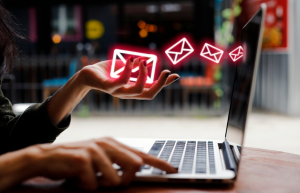A/B tests: Experiment personalization
Personalization means making content, images and text modules constantly new and relevant for customers. Even if personalized actions don’t deliver the desired result, that’s not a failure. You will receive further data and valuable insights on the basis of which you can further optimize the personalized customer experience. Therefore, adjust your failure culture. A failed test is an “increase in knowledge”, a learning.
Not ABC, but A/B and P
A/B tests can help here. Usually one uses A/B tests, by dividing its target group into two groups and/or a zero group (this sees the standard) and a test group (this sees the test) and presenting you two variants e.g. of a web page, a newsletter or a Google advertisement. The variants may only differ slightly, i.e. only in one point. The variants are then swapped and the reactions of the two groups are compared with the previous reactions.
In the case of the website, the tests are often used to; identify adjustments to the website for usability, so that in the end all visitors to a website benefit (macro-targeting). Personalization is used more extensively and ensures optimization of the entire customer journey, including an individual, customized website (micro-targeting).

However, A/B tests can also be used in a supportive manner in the case of personalization. A combination of both methods optimizes personalization. Here, A/B tests are carried out on a broadly diversified customer base in order to then identify the customer groups or segments with the help of these test results. The aim is to find out which customer groups respond best to individual test concepts. This then helps with the personalization concepts.
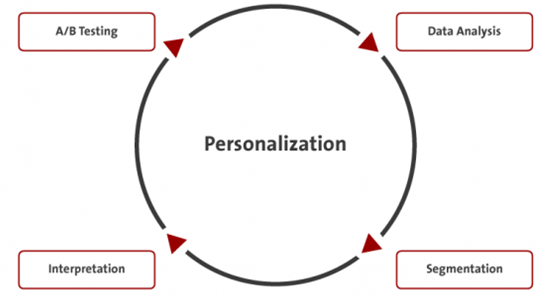
https://www.konversionskraft.de/personalisierung/personalisierung-4-schritte.html (04.06.02016)
Use the possibilities of A/B tests. Experiment on the content side, continuously measure and analyze the information and data gained, and gradually increase your level of personalization. Additionally, create a process for incorporating external insights. Start small and grow with your tasks. Always test extremely! I.e. don’t test because of a few percentage points, but always take the approach that (hopefully) produces a 20% or 30% better result. Otherwise, the result might not be significant, i.e. statistically random.
You can find all 5 parts compactly in a free ePaper with tips & tricks here:
Personalization, the non plus ultra of personalization?
One-to-one personalization is considered the highest and most desirable form of personalization. However, there are studies that prove that this mature form of personalization is not necessary to achieve success. Even segmentation of target groups brings benefits; further selection into micro-segments achieves the greatest effect.
So take a look at your target group segmentation and think about how you can possibly structure it even more micro-segmented based on your data. Then you will already be greatly helped for your personalization measures.
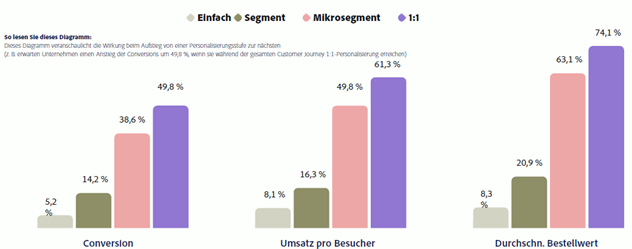
Personalization vs. individualization
Although the terms personalization and individualization are often used synonymously, they describe two different strategies in marketing. The easiest way to distinguish between the two methods is to look at the actor.
In the case of individualization, it is the user or customer who determines how a product, service or even a website should look. This strategy is particularly effective for products in e-commerce: instead of a mass product, the consumer creates his or her own unique product according to individual tastes (product customization – mass customization).
In the case of personalization, on the other hand, it is the company or the provider that uses its data situation to determine which formats and content are personalized in order to achieve a tailored customer approach.
These two methods can also be confused when it comes to customizing a website, as both adapt the content and functionality of a website to better meet the individual needs of visitors. In customization, the user is given the opportunity to adjust the content, presentation, and search settings based on their interests and preferences. With personalization, based on the customer’s existing data or, in the case of potential customers, based on behavioral data (page views, browsing behavior, etc.), the website is customized in real time.
However, personalization and individualization have one thing in common, which is certainly one reason why these terms are often misused for each other: Both are about customers’ need for recognition and companies’ ability to show appreciation and understanding for customers’ individual desires and interests. The feeling of having a very special bond with a company or brand is evoked by both individualization and personalization.
And can personalization also be used in B2B?
Leaving aside the fact that some consultants talk about human to human (H2H) when addressing customers (because it’s always people facing each other and making decisions), there are differences in personalization when addressing consumers (B2C) and people acting on behalf of their company (B2B) that you should consider. That is, if it affects you as a reader.
Unlike in B2C, companies in B2B need to keep in mind not just one customer, but the needs of multiple stakeholders (the buying center), as there are usually multiple people involved in buying decisions. Focus and search behavior for information about products and services are different and must be taken into account when creating relevant content.
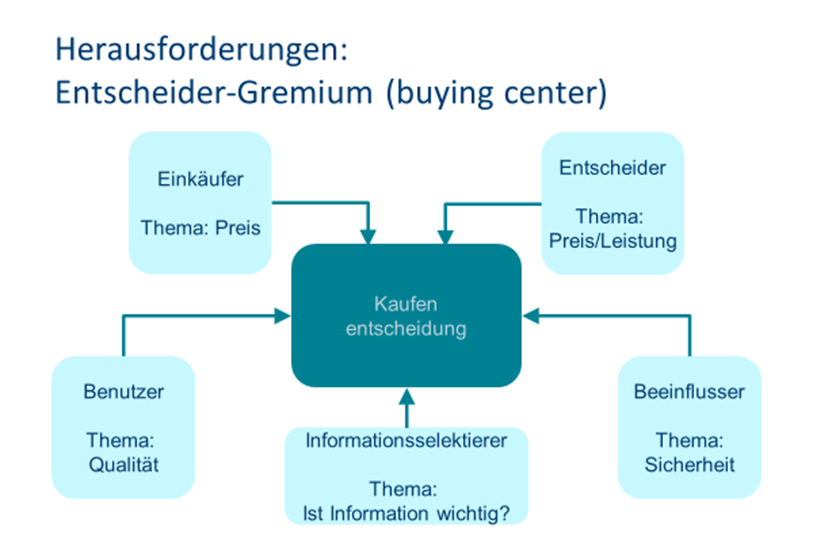
Collecting data for personalization is also much more difficult. It is often not possible to generate usable data on devices used for business purposes. If the employer then also approves private use of the business cell phone, for example, the data required for personalization cannot be collected cleanly. The key here is to collect as much relevant data as possible.
Hyper-personalization, identity marketing or the simple question: Where are we with personalization?
The topic of personalization has been around for over 30 years. Its importance for today’s customer dialog has been emphasized often enough and proven in studies. As with many topics, there are also developments and dissenting voices – the latter are becoming more and more frequent. Let’s take a look at both.
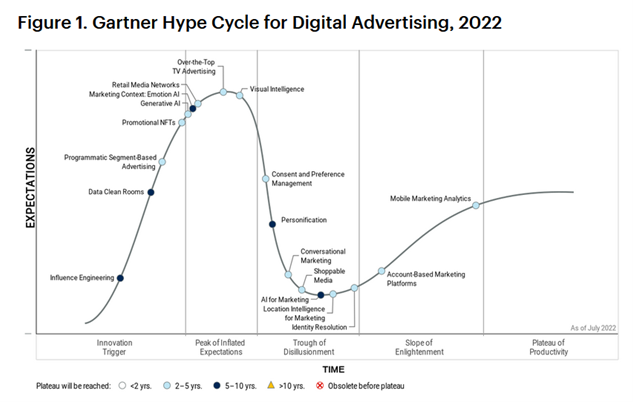
After years of invoking the meaning of personalization, we are currently – according to Gartner – supposedly in the valley of disappointment. Many companies are struggling to implement and set up successful measures due to the high costs and the difficulty of integrating data and systems.
What are the biggest challenges for a successful personalization strategy?
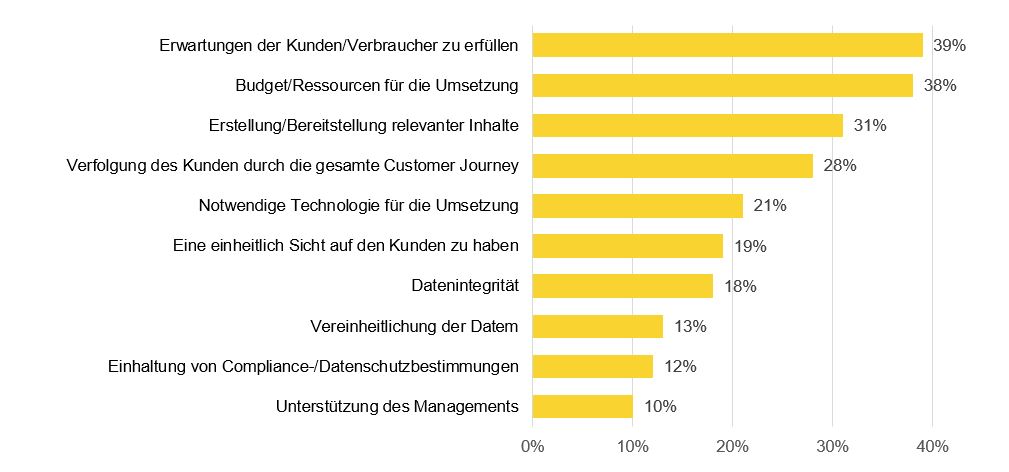
Hyper-personalization – personalization to the extreme?
Let’s take a look at the term hyper-personalization, the most extreme form of personalization.
In contrast to personalization, this term is used to indicate that companies are going into even more detail and specifics in order to provide customers with an optimal customer experience. To make this possible, existing data and customer insights are also used here. But these are being combined even more with real-time and behavioral data that comes from the use of artificial intelligence (AI) and advanced automation. For some, however, this is nothing more than personalization, just in its optimal, more advanced form.
Affiliation as a personalization element
Let’s move on to identity marketing. Again, this is said to change personalization. Identity is what makes us as a person or human being. It can distinguish us from others or it can connect us through shared values and experiences and create a sense of belonging. Identity marketing builds on the latter, creating segment-based campaigns based, for example, on meaningful identity attributes such as people’s occupation or life stage. This could be a fine-grained form of Sinus Milieus, for example.
Whatever you call it, ultimately it’s about entering into a dialogue with the customer that helps them and the company. To do this, you have to turn on your head, develop a strategy, use tools, but treat them as tools and not as commanders. Purposefully collect data with a mind and always think carefully about what you really need, experiment and try it out, but then also draw the (right) conclusions from it and develop personalization further.
Think about what information customers are willing to share and what you, as a company, need to provide in return.
What customers like to share
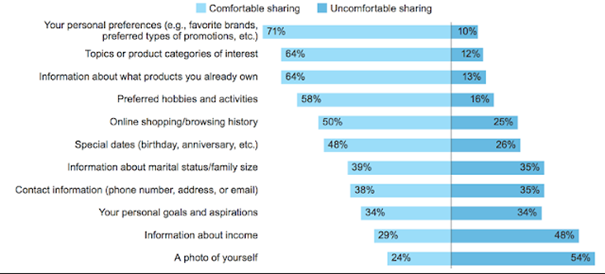
Conclusion and Tip:
Personalization is an important field. We are all happy to be addressed by name, when our name…
You can find the complete article here as a free download:
Go to
Part 1: Why personalization is not a nice-to-have
Part 2: Are you still collecting or are you already personalizing?
Part 3: Personalization needs suitable structures
Part 4: Hey personalization, what works?
Note: This is a machine translation. It is neither 100% complete or 100% correct. We can therefore not guarantee the result.








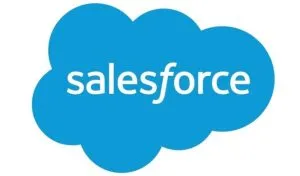

 CAS Software AG ist Marktführer für Kundenbeziehungsmanagement (CRM) im deutschen Mittelstand. Ob Marketing, Vertrieb oder Service – Anwender profitieren von effizienten Prozessen auf einer einheitlichen Datenbasis.
CAS Software AG ist Marktführer für Kundenbeziehungsmanagement (CRM) im deutschen Mittelstand. Ob Marketing, Vertrieb oder Service – Anwender profitieren von effizienten Prozessen auf einer einheitlichen Datenbasis.



